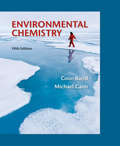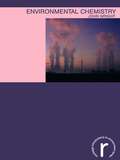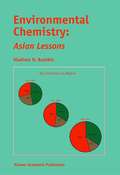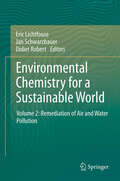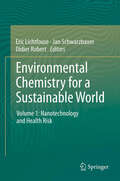- Table View
- List View
Environmental Chemistry
by Colin Baird MICHAEL CANNColin Baird and Michael Cann’s acclaimed textbook helps students explore chemical processes and properties underlying environmental issues they hear about and discuss every day. Issues such as climate change, pollution, biofuels, sustainability and many more are dissected throughout the title. With an updated and balanced coverage of soil, water and air chemistry, the fifth edition pays close attention to the environmental impacts of chemical production and experimentation. A textbook that stands out from others looking at environmental chemistry as it makes these environmental problems accessible to students.
Environmental Chemistry
by J. O'M. BockrisThere is no need in the 1970s to explain the writing of a book on "Environmen tal Chemistry. " The despoliation of the environment by man's activities has long been clear to chemists. However, it has been the subject of public debate for a short time-since the late 1960s. Curiously, there has been little reaction in the textbook literature to reflect this concern. Apart from some brief and sketchy paperbacks for schools, there has not yet been published a substantial review of environmental chemistry. One reason for this is the breadth of the chemistry involved: it could scarcely be covered by one or two authors, for it is as wide as chemistry itself. The ideal way to write such a book would be to gather a couple of dozen authors in one place and keep them together for 6 months of discussions and writing. This not being very practical, it was decided to do the next best thing and to attempt to network a number of men together in mutual correspondence and interaction, which would lead to a book that had the advantages of the expertise of a large number of persons, and lacked many of the usual disadvan tages of the multi author book. Thus, synopses of the various articles were sent to each author, and they were encouraged to interact with each other in attempting to avoid repetition and in keeping their symbols uniform and their presentation style coordinated.
Environmental Chemistry: A Comprehensive Approach
by Muhammad A. Hanif Farwa Nadeem Ijaz Ahmad Bhatti Hafiz Muhammad TauqeerThis book is a very comprehensive project designed to provide complete information about environmental chemistry, including air, water, soil and all life forms on earth. The complete chemical composition and all the essential components of the atmosphere, hydrosphere, geosphere, lithosphere and biosphere are discussed in detail. Numerous forms of pollutants and their toxic effects along with sustainable solutions are provided. Not just covering the basics of environmental chemistry, the authors discuss many specific areas and issues, and they provide practical solutions. The problems of non-renewable energy processes and the merits of renewable energy processes along with future fuels are discussed in detail, making this volume a comprehensive collaboration of many other relevant fields which tries to fill the knowledge gap of all previously available books on the market. It also thoroughly covers all environment-related issues, internationally recognized standard values, and the socioeconomic impacts on society for the short and long term. A valuable reference for engineers, scientists, chemists, and students, this volume is applicable to many different fields, across many different industries, at all levels. It is a must-have for any library.
Environmental Chemistry: A Comprehensive Approach
by Muhammad A. Hanif Farwa Nadeem Ijaz Ahmad Bhatti Hafiz Muhammad TauqeerThis book is a very comprehensive project designed to provide complete information about environmental chemistry, including air, water, soil and all life forms on earth. The complete chemical composition and all the essential components of the atmosphere, hydrosphere, geosphere, lithosphere and biosphere are discussed in detail. Numerous forms of pollutants and their toxic effects along with sustainable solutions are provided. Not just covering the basics of environmental chemistry, the authors discuss many specific areas and issues, and they provide practical solutions. The problems of non-renewable energy processes and the merits of renewable energy processes along with future fuels are discussed in detail, making this volume a comprehensive collaboration of many other relevant fields which tries to fill the knowledge gap of all previously available books on the market. It also thoroughly covers all environment-related issues, internationally recognized standard values, and the socioeconomic impacts on society for the short and long term. A valuable reference for engineers, scientists, chemists, and students, this volume is applicable to many different fields, across many different industries, at all levels. It is a must-have for any library.
Environmental Chemistry: Microscale Laboratory Experiments
by Jorge G. Ibanez Margarita Hernandez-Esparza Carmen Doria-Serrano Arturo Fregoso-Infante Mono Mohan SinghThis book presents chemical analyses of the most pressing waste, pollution, and resource problems for the undergraduate or graduate student. Its distinctive holistic approach provides a solid introduction to theory as well as a practical laboratory manual detailing beginning and advanced experimental applications. It presents laboratory procedures at microscale conditions, for minimum waste and maximum economy.
Environmental Chemistry: Fundamentals
by Jorge G. Ibanez Margarita Hernandez-Esparza Carmen Doria-Serrano Arturo Fregoso-Infante Mono Mohan SinghThis book presents chemical analyses of our most pressing waste, pollution, and resource problems for the undergraduate or graduate student. The distinctive holistic approach provides both a solid ground in theory, as well as a laboratory manual detailing introductory and advanced experimental applications. The laboratory procedures are presented at microscale conditions, for minimum waste and maximum economy. This work fulfills an urgent need for an introductory text in environmental chemistry combining theory and practice, and is a valuable tool for preparing the next generation of environmental scientists.
Environmental Chemistry: Green Chemistry and Pollutants in Ecosystems
by Eric Lichtfouse Jan Schwarzbauer Didier RobertThis book describes advances in this new, fast developing science, which seeks to decipher fundamental mechanisms ruling the behaviour in water, soils, atmosphere, food and living organisms of toxic metals, fossil fuels, pesticides and other organic pollutants. Sections on eco-toxicology, green chemistry, and analytical chemistry round out this thorough survey of conditions and analytical techniques in an emerging specialty.
Environmental Chemistry
by Stanley ManahanWith clear explanations, real-world examples and updated questions and answers, the tenth edition of Environmental Chemistry emphasizes the concepts essential to the practice of environmental science, technology and chemistry while introducing the newest innovations in the field. The author follows the general format and organization popular in preceding editions, including an approach based upon the five environmental spheres and the relationship of environmental chemistry to the key concepts of sustainability, industrial ecology and green chemistry. This readily adaptable text has been revamped to emphasize important topics such as the world water crisis. It details global climate change to a greater degree than previous editions, underlining the importance of abundant renewable energy in minimizing human influences on climate. Environmental Chemistry is designed for a wide range of graduate and undergraduate courses in environmental chemistry, environmental science and sustainability as well as serving as a general reference work for professionals in the environmental sciences and engineering.
Environmental Chemistry
by Stanley ManahanWith clear explanations, real-world examples and updated questions and answers, the tenth edition of Environmental Chemistry emphasizes the concepts essential to the practice of environmental science, technology and chemistry while introducing the newest innovations in the field. The author follows the general format and organization popular in preceding editions, including an approach based upon the five environmental spheres and the relationship of environmental chemistry to the key concepts of sustainability, industrial ecology and green chemistry. This readily adaptable text has been revamped to emphasize important topics such as the world water crisis. It details global climate change to a greater degree than previous editions, underlining the importance of abundant renewable energy in minimizing human influences on climate. Environmental Chemistry is designed for a wide range of graduate and undergraduate courses in environmental chemistry, environmental science and sustainability as well as serving as a general reference work for professionals in the environmental sciences and engineering.
Environmental Chemistry
by Stanley E. ManahanThe field of environmental chemistry has evolved significantly since the publication of the first edition of Environmental Chemistry. Throughout the book's long life, it has chronicled emerging issues such as organochloride pesticides, detergent phosphates, stratospheric ozone depletion, the banning of chlorofluorocarbons, and greenhouse warming. D
Environmental Chemistry: Eleventh Edition
by Stanley E ManahanWith clear explanations, real-world examples and updated ancillary material, the 11th edition of Environmental Chemistry emphasizes the concepts essential to the practice of environmental science, technology and chemistry. The format and organization popular in preceding editions is used, including an approach based upon the five environmental spheres and the relationship of environmental chemistry to the key concepts of sustainability, industrial ecology and green chemistry. The new edition provides a comprehensive view of key environmental issues, and significantly looks at diseases and pandemics as an environmental problem influenced by other environmental concerns like climate change. Features: The most trusted and best-selling text for environmental chemistry has been fully updated and expanded once again The author has preserved the basic format with appropriate updates including a comprehensive overview of key environmental issues and concerns New to this important text is material on the threat of pathogens and disease, deadly past pandemics that killed millions, recently emerged diseases and the prospects for more environment threats related to disease This outstanding legacy appeals to a wide audience and can also be an ideal interdisciplinary book for graduate students with degrees in a variety of disciplines other than chemistry New! Long-awaited companion website featuring additional ancillary material
Environmental Chemistry: Eleventh Edition
by Stanley E ManahanWith clear explanations, real-world examples and updated ancillary material, the 11th edition of Environmental Chemistry emphasizes the concepts essential to the practice of environmental science, technology and chemistry. The format and organization popular in preceding editions is used, including an approach based upon the five environmental spheres and the relationship of environmental chemistry to the key concepts of sustainability, industrial ecology and green chemistry. The new edition provides a comprehensive view of key environmental issues, and significantly looks at diseases and pandemics as an environmental problem influenced by other environmental concerns like climate change. Features: The most trusted and best-selling text for environmental chemistry has been fully updated and expanded once again The author has preserved the basic format with appropriate updates including a comprehensive overview of key environmental issues and concerns New to this important text is material on the threat of pathogens and disease, deadly past pandemics that killed millions, recently emerged diseases and the prospects for more environment threats related to disease This outstanding legacy appeals to a wide audience and can also be an ideal interdisciplinary book for graduate students with degrees in a variety of disciplines other than chemistry New! Long-awaited companion website featuring additional ancillary material
Environmental Chemistry
by Peter O'NeillA complete introduction to environmental chemistry, this book provides insight into the operation of the chemical processes near the Earth's surface. The four-part format groups together related environmental topics and introduces theoretical concepts. Part One brings together many essential basic geological, geochemical, and chemical ideas, and emphasizes the importance of oxygen to the chemistry of reactions near the Earth's surface. Parts Two and Three discuss systems depending on these reaction types, and Part Four examines the effects of human activities on elements that usually cycle naturally in small quantities. Also in this part, the perturbation of natural cycles by agricultural, industrial, and social developments is highlighted in terms of the consequent problems of environmental management.
Environmental Chemistry
by Peter O'NeillA complete introduction to environmental chemistry, this book provides insight into the operation of the chemical processes near the Earth's surface. The four-part format groups together related environmental topics and introduces theoretical concepts. Part One brings together many essential basic geological, geochemical, and chemical ideas, and emphasizes the importance of oxygen to the chemistry of reactions near the Earth's surface. Parts Two and Three discuss systems depending on these reaction types, and Part Four examines the effects of human activities on elements that usually cycle naturally in small quantities. Also in this part, the perturbation of natural cycles by agricultural, industrial, and social developments is highlighted in terms of the consequent problems of environmental management.
Environmental Chemistry: An Analytical Approach
by Kenneth S. OverwayCovers the essentials of environmental chemistry and focuses on measurements that can be made in a typical undergraduate laboratory Provides a review of general chemistry nestled in the story of the Big Bang and the formation of the Earth Includes a primer on measurement statistics and quantitative methods to equip students to make measurements in lab Encapsulates environmental chemistry in three chapters on the atmosphere, lithosphere and hydrosphere Describes many instruments and methods used to make common environmental measurements
Environmental Chemistry: An Analytical Approach
by Kenneth S. OverwayCovers the essentials of environmental chemistry and focuses on measurements that can be made in a typical undergraduate laboratory Provides a review of general chemistry nestled in the story of the Big Bang and the formation of the Earth Includes a primer on measurement statistics and quantitative methods to equip students to make measurements in lab Encapsulates environmental chemistry in three chapters on the atmosphere, lithosphere and hydrosphere Describes many instruments and methods used to make common environmental measurements
Environmental Chemistry: A global perspective
by Gary W. vanLoon Stephen J. DuffyChemical processes shape the world we live in; the air we breathe, the water we drink, the weather we experience. Environmental Chemistry: a global perspective describes those chemical principles which underpin the natural processes occurring within and between the air, water, and soil, and explores how human activities impact on these processes, giving rise to environmental issues of global concern. Guiding us through the chemical composition of the three key environmental systems - the atmosphere, hydrosphere, and terrestrial environment - the authors explain the chemical processes which occur within and between each system. Focusing on general principles, we are introduced to the essential chemical concepts which allow better understanding of air, water, and soil and how they behave; careful explanations ensure that clarity is not sacrificed at the expense of thorough coverage of the underlying chemistry. We then see how human activity continues to affect the chemical behaviour of these environmental systems, and what the consequences of these natural processes being disturbed can be. Environmental Chemistry: a global perspective takes chemistry out of the laboratory, and shows us its importance in the world around us. With illuminating examples from around the globe, its rich pedagogy, and broad, carefully structured coverage, this book is the perfect resource for any environmental chemistry student wishing to develop a thorough understanding of their subject.
Environmental Chemistry: A global perspective
by Gary W. vanLoon Stephen J. DuffyChemical processes shape the world we live in; the air we breathe, the water we drink, the weather we experience. Environmental Chemistry: a global perspective describes those chemical principles which underpin the natural processes occurring within and between the air, water, and soil, and explores how human activities impact on these processes, giving rise to environmental issues of global concern. Guiding us through the chemical composition of the three key environmental systems - the atmosphere, hydrosphere, and terrestrial environment - the authors explain the chemical processes which occur within and between each system. Focusing on general principles, we are introduced to the essential chemical concepts which allow better understanding of air, water, and soil and how they behave; careful explanations ensure that clarity is not sacrificed at the expense of thorough coverage of the underlying chemistry. We then see how human activity continues to affect the chemical behaviour of these environmental systems, and what the consequences of these natural processes being disturbed can be. Environmental Chemistry: a global perspective takes chemistry out of the laboratory, and shows us its importance in the world around us. With illuminating examples from around the globe, its rich pedagogy, and broad, carefully structured coverage, this book is the perfect resource for any environmental chemistry student wishing to develop a thorough understanding of their subject.
Environmental Chemistry
by John WrightMany controversial issues revolve around complex scientific arguments which can be better understood with at least a minimal knowledge and understanding of the chemical reactions and processes going on in the world around us.This textbook offers an accessible introduction to chemical principles and concepts, and applies them to relevant environmental situations and issues. Written for students who have not taken A' level chemistry, this book bridges the gap between GSCE chemistry and first year undergraduate level.
Environmental Chemistry
by John WrightMany controversial issues revolve around complex scientific arguments which can be better understood with at least a minimal knowledge and understanding of the chemical reactions and processes going on in the world around us.This textbook offers an accessible introduction to chemical principles and concepts, and applies them to relevant environmental situations and issues. Written for students who have not taken A' level chemistry, this book bridges the gap between GSCE chemistry and first year undergraduate level.
Environmental Chemistry: Asian Lessons
by V.N. BashkinAt present environmental chemistry is becoming an increasingly popular subject in both under graduate and graduated education in the whole World and especially in all Asian countries. Different courses in ecology, chemistry, environmental science, public health, geography, biology, and environmental engineering all include this subject in their curriculum. Many textbooks have appeared in recent years aiming to fulfill these requirements; however, most of these books operate mainly with examples from developed countries of Europe, USA and Canada. Taking into account the geographic boundaries of environmental pollution that is especially pronounced in Asia and the specific peculiarities of pollution in developing countries, this textbook is supposed to close the gap by providing regionally oriented knowledge in basic and applied environmental chemistry.
Environmental Chemistry for a Sustainable World: Volume 2: Remediation of Air and Water Pollution (Environmental Chemistry for a Sustainable World #2)
by Eric Lichtfouse, Jan Schwarzbauer and Didier RobertEnvironmental chemistry is a fast developing science aimed at deciphering fundamental mechanisms ruling the behaviour of pollutants in ecosystems. Applying this knowledge to current environmental issues leads to the remediation of environmental media, and to new, low energy, low emission, sustainable processes. Chapters review analysis and remediation of pollutants such as greenhouse gases, chiral pharmaceuticals, dyes, chlorinated organics, arsenic, toxic metals and pathogen in air, water, plant and soil. Several highlights include the overlooked impact of air pollutants from buildings for health risk, innovative remediation techniques such as bioreactors for gas treatment, electrochemical cleaning of pharmaceuticals, sequestration on Fe-Mn nodules, phytoremediation and photocatalytical inactivation of microbial pathogens. This book will be a valuable source of information for engineers and students developing novel applied techniques to monitor and clean pollutants in air, wastewater, soils and sediments.
Environmental Chemistry for a Sustainable World: Volume 1: Nanotechnology and Health Risk (Environmental Chemistry for a Sustainable World #1)
by Eric Lichtfouse, Jan Schwarzbauer and Didier RobertEnvironmental chemistry is a fast developing science aimed at deciphering fundamental mechanisms ruling the behaviour of pollutants in ecosystems. Applying this knowledge to current environmental issues leads to the remediation of environmental media, and to new, low energy, low emission, sustainable processes. Nanotechnology applications for alternative energies such as solar power, fuel cells, hydrogen and lithium batteries are reviewed in the first section. Recent investigations on carbon nanotubes, nanocatalysts and cyclodextrins disclose unprecedented techniques to monitor and clean pollutants such as greenhouse gases, heavy metals, pesticides, pathogens occurring in water, air and soil. The second section reviews the risks for human health of critical pollutants such as endocrine disruptors, dioxins and heavy metals contaminating seafood and sediments. An exhaustive review of DDT isomers reveals unexpected mechanisms of DDT transfer to fishes. A chapter on pollutant geochronology using river sedimentary archives provides novel insights on pollution history since the beginning of the anthropocene. This book will be a valuable source of information for engineers and students developing novel applied techniques to monitor and clean pollutants in air, wastewater, soils and sediments.
Environmental Chemistry in Society
by James M. BeardTaking a nonmathematical approach to the material, Environmental Chemistry in Society presents the chemistry of the environment in a way accessible to students who have little or no science background. It relates the fundamentals of chemistry to contemporary environmental issues. Shows the Relevance of Chemistry in the Environment Requiring no prio
Environmental Chemistry in Society
by James M. BeardEveryone can benefit from having some understanding of environmental science and the chemistry underlying issues such as global warming, ozone depletion, energy sources, air pollution, water pollution, and waste disposal. Environmental Chemistry in Society, Second Edition presents environmental science to the non-science student, specifically focus
